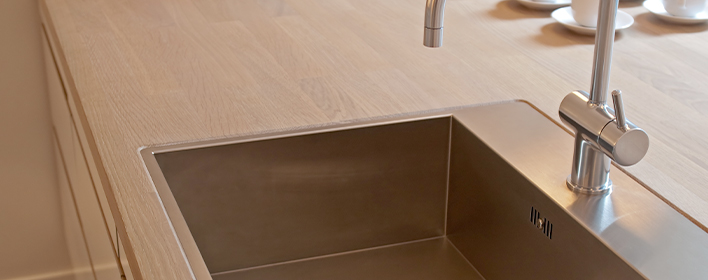
Cleaning Stainless Steel Sinks
The distinctive shine of stainless steel is found everywhere you look — from the kitchen sink to the pinnacle of the Chrysler Building. And no wonder: It’s a high- performance marvel, an extremely durable material that does not corrode or rust.
It doesn’t stain easily, either, although it’s not stain-proof. Low maintenance and distinctive luster make it popular for use in cookware, cutlery, hardware, and major appliances like refrigerators and stovetops, as well as surgical instruments and many industrial applications.
A film of chromium makes it resistant to rusting and tarnishing, but the surface of the sink can be damaged by dirt and grime so the stainless steel must be kept clean.
Follow these tips to keep your stainless steel sink shining.
1. Using Abrasives:
Another way to remove food or grease remains after cleaning your pots and pans (maybe this didn’t get rinsed away), sprinkle a little baking soda in the sink and scrub with a paper towel, sponge, or damp cloth. You don’t need to open a new box of baking soda. Using some from the open box in the refrigerator will be fine.
While you can choose to use Comet, Ajax, or another abrasive cleaner, baking soda is a more natural alternative. Plus, it will remove odors from the sink and from the drain.
Always scrub in the direction of the grain, not against it to avoid scratching.
2. Shining and Removing Streaks from Stainless Steel:
The next time you use lemon for cooking, save it for cleaning your stainless sink after dinner. Depending on how you’ve used the lemon cut it in half and rub the cut ends around the sink.
Finally, to remove any streaks that remain after cleaning your stainless steel sink, wipe the sink down with club soda or olive oil. Pour a bit of either on a paper towel or cloth and rub over the entire surface.
3. Pour some rubbing alcohol or other chemical solvents
Sometimes, you may notice a sticky film on your stovetop, hood, or grill that appears when the stainless steel comes into contact with grease from cooking or other contaminants. While grease or other soils may not be corrosive, they may compromise the availability of the stainless steel surface to maintain passivity (the ability to prevent corrosion).
To clean, simply pour a small amount of rubbing alcohol onto a soft cloth and rub until the greasy spots disappear. As with the other methods, be sure to rinse off the alcohol with warm water and dry the stainless steel to make it gleam like new!
4.Try warm water
It’s true: Most of the time, stainless steel will come clean with warm water, with or without a gentle detergent. Simply rinse your stainless steel pots or cutlery in the sink and clean them with a gentle cloth. If you’d like, add a little of your favorite household detergent to make the job easier.
Sometimes water may contain mineral solids that can leave water spots on stainless steel, so wipe thoroughly with dry towels to keep your pots and pans or appliances looking their best.
Keeping Your Stainless Steel Sink Looking It’s Best:
– Evite los limpiadores gruesos o abrasivos:
Los limpiadores abrasivos dañarán el acero inoxidable al rayar la superficie. Los acabados de superficie mate no se rayan tan fácilmente como lo hace el acero inoxidable altamente pulido. Pruebe todos los limpiadores en un lugar escondido antes de usarlos. Frote siempre a favor de la veta, no en contra.
– Siempre enjuague el fregadero limpio:
La suciedad, la mugre y los residuos de los productos de limpieza que se dejan reposar sobre el acero inoxidable pueden causar manchas o dañar el acabado.
– No utilice cepillos de lana de acero o de cerdas de acero:
El acero inoxidable ha sido pulido y el uso de lana de acero o cepillos de cerdas de acero rayará el acabado. Cualquier óxido en estas herramientas de limpieza puede causar que se forme óxido en la superficie del fregadero de acero inoxidable.
